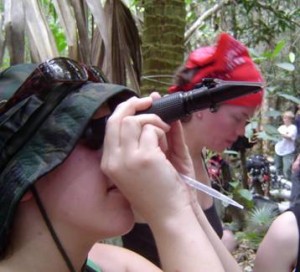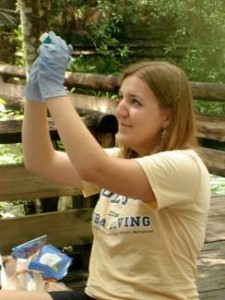Geochemistry
Geochemistry is the study of earth’s chemical composition and the reactions that occur to transport chemicals between earth and in the atmosphere. These reactions include processes such as weathering, cave formation, erosion, oxidation, etc. Often these processes are influenced by microorganisms, who play an important role in altering chemicals (such as sulfur, iron, etc.), within their respective cycles, and this is the study of biogeochemistry.
Geochemical paramaters of the caves/springs we study are measured using a variety of instruments. In addition to monitoring temperature, pH, dissolved oxygen, oxidation/reduction potential, specific conductance, turbidity, and salinity, our scientists are also interested in looking at concentrations of nitrate, sulfur, iron, manganese, calcium, etc. as the combination of all of these chemical constituents influences what organisms live where.
Cave microbes play an important role in altering the chemical composition of limestone (or soil, bedrock, etc., depending on where they live). For example, at Wekiwa Springs, sulfur-oxidizing bacteria are capable of utilizing elemental sulfur as it is found in the bedrock as their energy source (instead of sunlight). Metabolic and physiologic processes within their body tissues then transform the sulfur into a useable “form” that allows them to make their own food and function as “chemolithoautotrophic” bacteria. (“Chemo” refers to “chemicals”; “litho” is from the Greek lithos meaning “stone, or rock”; auto means “self”; and troph is another way of saying “food or feeding”.)



